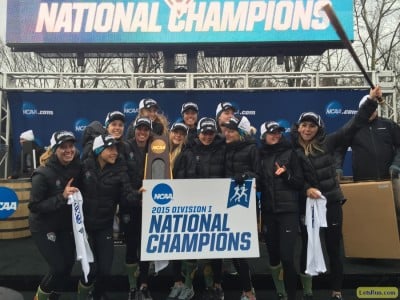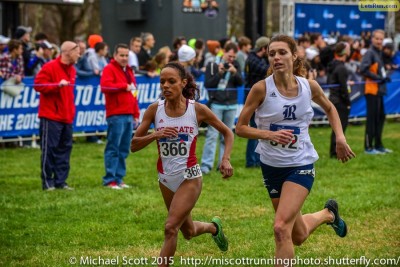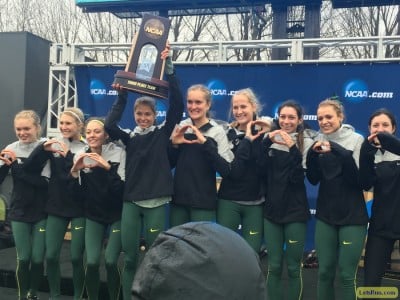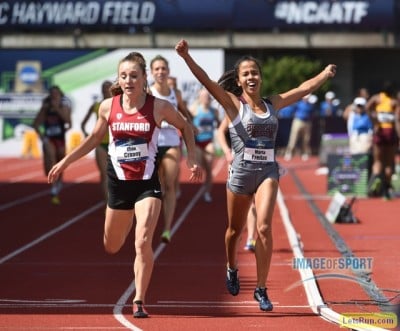2016 NCAA Women’s XC Preview: #6 New Mexico, #5 NC State, #4 Oregon and #3 Stanford
By LetsRun.com
September 20, 2016
Cross country is back, and while the season is not yet in full swing, we’ve already reached the point in the season where meets count for at-large qualifying purposes for NCAAs. A new rule this year means that you can get points at any meet held September 9 or later but for the most part that has meant next to nothing as most coaches are still running B teams. Between the Summer Olympics and the Diamond League, we didn’t have any time to focus on collegiate XC, but given that basically nothing has happened of yet, we have little reason to apologize for being a little late to the party. Now it’s time to get ready for the season. We’re doing that by rolling out previews for the top 10 men’s and women’s teams in the country.
Our pre-season rankings are only a rough estimate of what will happen this fall. While we did correctly predict the top two women’s teams last fall in order (#1 New Mexico and #2 Colorado), we only predicted six of the top 10 teams on the women’s side and five of the top 10 teams on the men’s side, with two of our preseason top five — the Wisconsin and Villanova men — failing to qualify for NCAAs entirely. A lot can change between now and November 19, when the NCAA championships return to Terre Haute, Ind., and while it’s usually easy to predict the top teams, places six through 15 can often be interchangeable depending on who runs well on the day. That’s what happens when you’ve got roughly two guys crossing the finish line every second in the main pack. So consider these rankings a starting point for the national title conversation; we’ll check in periodically throughout the fall and offer analysis as the season unfolds.
Key dates
September 9: Meets begin to count for NCAA at-large qualifying purposes
October 14: Nuttycombe Wisconsin Invitational, Madison, Wis.
October 15: adidas Pre-National Invitational, Terre Haute, Ind.
October 28-30: Conference weekend (various sites)
November 11: NCAA regional meets (various sites)
November 19: NCAA championships, Terre Haute, Ind.
Previous women’s previews: *#10 Michigan State, #9 Oklahoma State, #8 Michigan, #7 Boise State
Note: We determined where a runner ranked among returners by taking her place in the team scoring at NCAAs in 2015 and subtracting the number of seniors/non-returners in front of her.
6. New Mexico: A different, but potentially dangerous Lobos squad
2015 results: 1st NCAAs, 2nd Mountain Regional, 1st Mountain West, 1st Wisconsin Invite, 1st Notre Dame Invite
Key returners (lose #1, 3, 5, 6, 7 from NCAAs last year)
| Name | Class | # returner from NCAAs | Credentials |
| Alice Wright | JR | 2 | 15:45/32:36; 2nd NCAA 10k |
| Calli Thackery | SR | 7 | 9:03/15:37; 6th NCAA indoor 3k |
| Kathryn Fluehr | SR | 40 | 16:21/34:29 |
| Natasha Bernal | SO | 16:27/10:19 steeple | |
| Kyoko Koyama | JR | 4:18/16:14 | |
| Sophie Connor | SR | 2:05/4:13 1500/9:44 | |
| Alex Buck | FR | 10:28 3200 |
If last year was a dream for New Mexico — dominant victories at Notre Dame, Wisconsin and the Mountain West Champs before a 49-point effort at nationals that made them the best women’s team in NCAA history — then 2016 has been a nightmare. Olympian Courtney Frerichs is out of eligibility and will not be returning. Ditto New Mexico’s #5 at NCAA last year, Molly Renfer. Those losses were expected and, on their own, not devastating considering the Lobos put three other women in the top 15 last year and were adding a fourth in Liberty transfer Ednah Kurgat. On paper, this year’s team was stacked, perhaps good enough to challenge the 2015 edition as the best-ever.
But what coach Joe Franklin deems “a series of unfortunate events” have derailed UNM’s repeat bid. First, Liberty chose not to release Kurgat, which means she’ll have to sit out her first year in Albuquerque per NCAA rules. Then last week, Franklin received confirmation that Rhona Auckland (13th last year), who raced just once outdoors, would miss the entire fall with a lower leg issue. So too will Lehigh transfer Elizabeth Weiler (38th at NCAAs two years ago), a potential reinforcement. Redshirt freshman Mackenzie Everett was not expected to be a major factor this fall, but she won’t race either.
“Last year obviously was incredibly unique in that there was literally no injury, no illness, no sickness, no nothing,” Franklin said. “This year it’s a little different. We didn’t have time to react [to the injuries]. Last year, if somebody was a little sick or tired, I’d say, ‘Take a couple days [off].’ We haven’t had that luxury this year.”
That means the Lobos enter 2016 as a very different team than the one that lifted the trophy in Louisville 10 months ago. Wright, who built on her 5th place finish at NCAAs last year (#2 returner) but taking second in the NCAA 10,000 in June, will be back to lead them, and Thackery has one year left as well. Princeton grad student Kathryn Fluehr (81st last year) is also training well, according to Franklin, who has a history of success with transfers and fifth-years, several of whom hailed from the Ivy League (Renfer and Sammy Silva from Harvard and Princeton’s Peter Callahan, to name a few).
Returning to the podium will be a tough task, but Franklin knows this squad can place highly at nationals.
“I think we’re still a very solid team,” Franklin said. “The goals from Day 1 have never really changed and those are to finish in the top 10. And that’s our goal: to figure out how to finish in the top 10.”
Having two low sticks up front really helps, and Franklin believes Natasha Bernal (10:19 steeple), freshman Alex Buck (10:28 3200 in HS) and Japanese transfer Kyoko Koyama (4:18/16:14) all have potential. If two of those three hit or Sophie Connor, 5th in the NCAA mile indoors, proves she can run XC, the Lobos will have a top-10 team. But there’s a lot of uncertainty, especially around Koyama, who has the potential to be great but is still adapting to the U.S. and had to travel back to Japan this week for a family emergency.
The Lobos should be good, but with deep Colorado and Providence squads ahead of them, it’s hard to imagine them repeating.
5. NC State: Wolfpack looks to run well all the way through November
2015 results: 5th NCAAs, 2nd Southeast Regional, 2nd ACCs, 4th Wisconsin Invite, 2nd Notre Dame Invite
Key returners (lose #3 from NCAAs last year)
| Name | Class | # returner from NCAAs | Credentials |
| Erika Kemp | SR | 25 | 9:06/15:45/33:13 |
| Rachel Koon | SO | 27 | 16:31 |
| Megan Moye | SR | 44 | 4:11 1500/16:33; 7th NCAA mile |
| Ryen Frazier | SO | 55 | 4:38 mile |
| Kaitlyn Kramer | SR | 69 | 16:31 |
| Alyssa Rudaswky | JR | 94 | 16:26 |
| Wesley Frazier | JR | 9:01/15:45 |
The Wolfpack are as talented as any team in the country, and though NC State’s fifth-place finish last year was the program’s best in 14 years, there was a sense around the program that they left more on the table.
“I felt like and, I think the team felt like, we never put it together on the same day so that was a little bit frustrating,” coach Laurie Henes said. “I think we had people run very solid races at the NCAA championships. We were fifth without an All-American which is certainly not necessarily the way we wanted to do that.”
NC State’s first big race last year was the Notre Dame Invitational, where the Wolfpack finished second behind eventual national champs New Mexico. True freshman Ryen Frazier won the race, defeating some very strong runners in the process — future Olympic finalist Courtney Frerichs and future NCAA XC champ Molly Seidel. But Frazier faded down the stretch and wound up 108th at NCAAs. She hasn’t raced since then, redshirting indoors and outdoors after developing stress reactions in both tibias.
“I think there were a lot of things at play there,” Henes said of Frazier. “I think we were really aggressive early in the season and we talked a lot about that. She’s never really had a full cross season like that. I think she learned quite a bit from it.”
Frazier’s older sister, Wesley, is another runner with vast potential — she ran 15:45 for 5,000 in 2015 and clocked 9:01 indoors (on a flat track no less) in her only track race of 2016. Wesley did not run outdoors due to a navicular injury but she’s been slowly building up since May. Henes’ husband has had two navicular injuries in the past and she knows from experience that it’s best to be cautious rather than risk a setback. Wesley, Ryen and a few others will delay their debuts this fall, likely until the Wisconsin Invite on October 14 or ACCs on October 28.
“Obviously the one race in uniform [for Wesley] was a 9:01 3k and she has run 15:45,” Henes said. “I think her potential in cross is pretty unlimited. She preferred track in the past, she wasn’t a big fan of NXN in high school. I think it will be a process learning to race big fields, but she’s excited about it and I think she’ll be ready to go.”
The Fraziers’ father, Timothy, is still involved in their training but Henes does not believe that will be an issue for the team. “There’s a collaborative effort at times,” Henes said, “but they’re both really invested in the program…they’re here because they want to be part of this program and run at a high level. I don’t think it’s tough to manage at all.”
Beyond the Fraziers, Erika Kemp (15:45, 5th at NCAA indoor 5k) and Megan Moye (4:11 1500, #2 among returners in the NCAA) both have the talent to be All-Americans and the Wolfpack have three other women at 16:31 or under. This could be a really, really good team if the Wolfpack learn from the mistakes of 2015. Henes felt that her women were too aggressive early in the race at ACCs, which cost them the team title by four points to Virginia, but with a veteran group led by seniors Kemp, Moye and Kaitlyn Kramer, this year’s team should be better equipped to handle the pressure of big races.
It’s been 10 years since the Wolfpack last celebrated an ACC title, but with the conference meet returning to NC State’s home course and defending champs Virginia taking some graduation hits, they’ve never had a better opportunity to end the drought. And if the Fraziers stay healthy and run to their potential, they could even threaten for a title in Terre Haute.
4. Oregon: The nation’s top recruit hopes to lead Ducks back to the podium
2015 results: 3rd NCAAs, 1st West Regional, 2nd Pac-12, 3rd Pre-Nats, 1st Washington Invite
Key returners (lose #1, #3, #6 from NCAAs last year)
| Name | Class | # returner from NCAAs | Credentials |
| Alli Cash | JR | 12 | 16:00; 5th NCAA 5k |
| Frida Berge | JR | 56 | 4:17/9:56 steeple |
| Ashley Maton | SR | 58 | 4:38 mile/16:30 |
| Maggie Schmaedick | SR | 66 | 16:09/33:54 |
| Katie Rainsberger | FR | 4:12 1500/9:00; NXN champ; 7th World U20 3k | |
| Samantha Nadel | SR | Georgetown transfer; 9:05/16:02; 37th NCAA XC ’14 |
Oregon has finished in the top six at NCAAs in four of the past five years, and the Ducks should make it five in six years when all is said and done in Terre Haute on November 19. Oregon takes some hits with the graduations of Waverly Neer and Molly Grabill, the team’s #1 and #3 runners at NCAAs last year, but they return Alli Cash (31st NCAAs XC, 5th in the NCAA 5k) and will be bolstered by two big additions that figure to have a major impact on the 2016 season. The first is freshman Katie Rainsberger from Colorado, the nation’s top recruit and last year’s NXN champion. Rainsberger recorded bests of 4:12 and 9:00 on the track this year, both of which would put her among the NCAA’s elite, and with a group of talented women to push her, she could reach even higher heights this year. Coach Maurica Powell will have to be careful not to ask too much of Rainsberger too soon, as her track season extended into late July (she was 7th at the World U20 champs 3k in Poland) but she’s a potential top-10 talent. The other addition, transfer Samantha Nadel from Georgetown, has plenty of big-race experience (she was the Hoyas’ #2 on their podium team in 2014) and should run in the Ducks’ top five.
With Cash and Rainsberger, the Ducks have a potentially powerful top two and some nice depth, with three other sub-16:10 women plus 4:18 1500 runner Lilli Burdon, a World U20 1500 finalist this summer for New Zealand. Oregon has lacked a real low stick since Jordan Hasay graduated in 2013, but the Ducks have still managed to run well at NCAAs the past two years thanks to their strong pack running. The same recipe this year — a couple of All-Americans, the rest of the top three in the top 100 — gives them a shot to land on the podium, especially if Cash or Rainsberger can emerge as true #1.
3. Stanford: The country’s top recruiting class sets up a potential dynasty
2015 results: 14th NCAAs, 4th West Regional, 3rd Pac-12, 4th Pre-Nats, 3rd Washington Invite
Key returners (lose #2, #3 from NCAAs last year)
| Name | Class | # returner from NCAAs | Credentials |
| Vanessa Fraser | JR | 18 | 4:19 1500/9:09/15:41 |
| Julia Maxwell | JR | 68 | 9:32/16:18 |
| Danielle Katz | SR | 85 | 9:21/16:09/10:11 steeple |
| Sophie Chase | SR | 91 | 9:23/16:33 |
| Hannah Long | SO | 129 | 2:04/4:44 mile |
| Elise Cranny | SO | 4:09/8:58/15:49; 2nd NCAA 1500; 12th NCAA XC ’14 | |
| Christina Aragon | FR | 2:04/4:08 1500; Olympic Trials 1500 semifinalist, bronze at World U20 champs | |
| Ella Donaghu | FR | 4:14 1500/10:25 3200; 2nd NXN | |
| Hannah DeBalsi | FR | 4:49 1600/9:55 3200; 3-time FL finalist (2nd, 5th, 12th) | |
| Fiona O’Keeffe | FR | 4:47 1600/10:04 3200; 4th NXN ’13 and ’14 |
Yes, it’s bold to project a 10-spot jump for the Cardinal, who have been on the podium just once in the past eight years. But no team in America improved more over the summer than the Stanford, who brought in one of the top recruiting classes in NCAA history. The headliner is Christina Aragon, daughter of 3:51 miler Chuck, who earned bronze in the 1500 at the World U20 Champs in Poland this summer, the first-ever medal in that event by an American (and just the second women’s medal in any event above 800 meters). Aragon’s 4:08.71 in that race has been bettered by just three high schoolers in history. In fact, of the seven fastest high school 1500 runners of all time, three of them — Aragon, Ella Donaghu and Elise Cranny — are on Stanford’s 2016 roster.
Donaghu (4:14 1500, 2nd at NXN), three-time Foot Locker finalist Hannah DeBalsi (2nd in ’13, 5th in ’14) and Fiona O’Keeffe, who was fourth at NXN as a sophomore and junior, join Aragon to form a cluster of super freshmen. High school prodigies are never a sure thing, particularly on the women’s side, but this group doesn’t need to get much better to have a big impact this fall. Aragon, in particular, needs only to maintain her current level to be a dominant force in the NCAA — her 4:08 was faster than any collegian ran last year. Of course, when so much of your potential is based on freshmen, there’s a lot of uncertainty, and we don’t know whether any or all of the new recruits will redshirt. In the past, Stanford has not been afraid to run its top talent right away (Elise Cranny) so if they’re healthy, we expect Aragon and Donaghu to run this fall. DeBalsi and O’Keeffe may redshirt unless they are fit enough to have an immediate impact.
There’s veteran talent on this roster too. Vanessa Fraser, the team’s top finisher at NCAAs in 2015, sliced 13 seconds off her 5k pb to get down to 15:41 in the spring. And Cranny, who redshirted last fall, returned to her old form on the track, running 4:09 and coming inches away from an NCAA 1500 title. A stronger, more experienced Cranny should improve on her 12th place finish in Terre Haute from two years ago, assuming she can stay healthy. Julia Maxwell (16:18) and Danielle Katz (16:09) provide solid depth.
With Cranny, Fraser and the fab four freshmen, Stanford appears loaded for years to come. There’s no pressure for Elizabeth Debole, who was promoted to head coach this fall, to deliver a title immediately, but the Cardinal are so good that they could arrive ahead of schedule and win it this year.
“I just look at it and go man, how does anybody beat that team?” Oklahoma State coach Dave Smith said. “They have got an incredible lineup. If we were going to run 5×1500, I don’t think anyone in the country would come close to that. And I think good athletes and good programs can figure out how to run 6k.”
Smith acknowledged that it can be a tough adjustment for stud recruits to go from the very front of every race in high school to running in a pack in college, but he believes that transition is easier, at least initially, for women than men. Three true freshmen finished in the top 10 at NCAAs last year on the women’s side.
“Much more than often than the men when they move to 10k, women contribute as freshmen,” Smith said. “The women for whatever reason, there seems to be more of them in a given year that can run in the top 30…They’re really moving up, most of them, from 5k to 6k. It’s not a huge change to what they’re doing, what they’re used to.”
Stanford will go as far as their freshman will take them, both now and in the years to come. There may not be pressure to win a title this year but there certainly will be in the years to come. One of the hardest things about coaching at a place like Stanford is national titles are almost expected, particularly when you’ve got such a great recruiting class, but the facts are Stanford hasn’t won since 2007 when they won their fourth title in five years.





